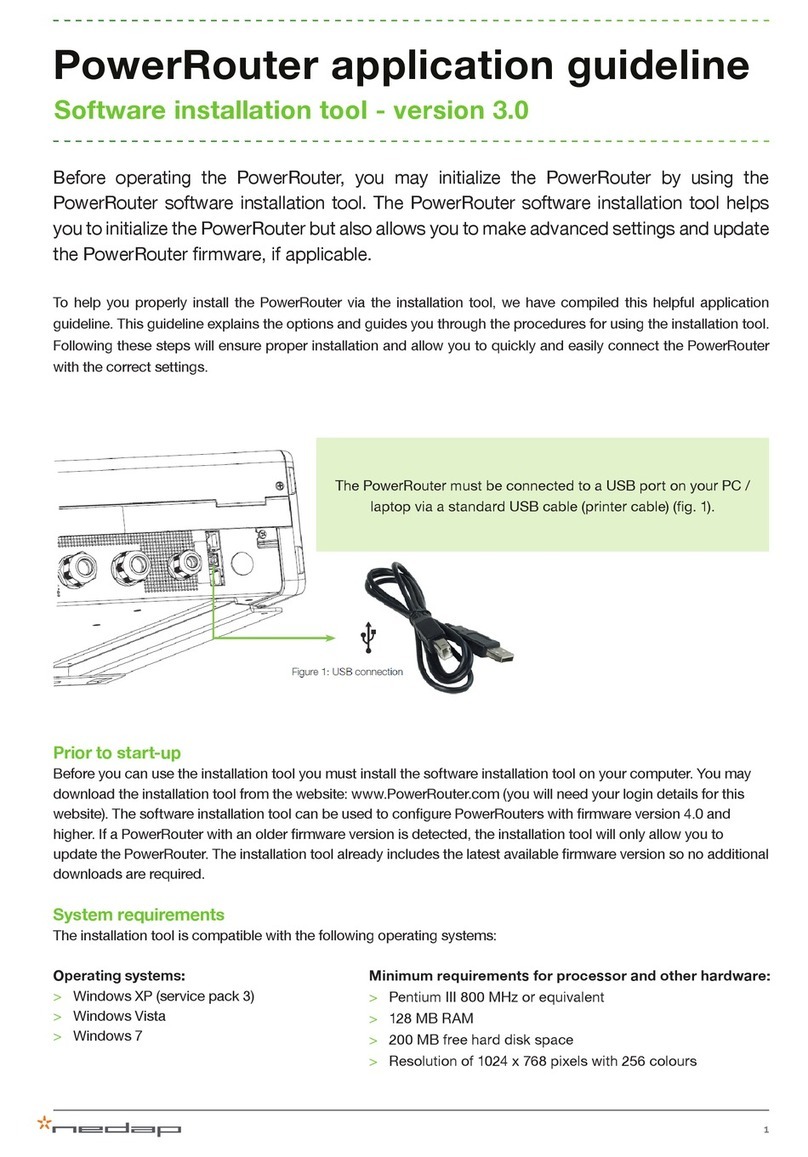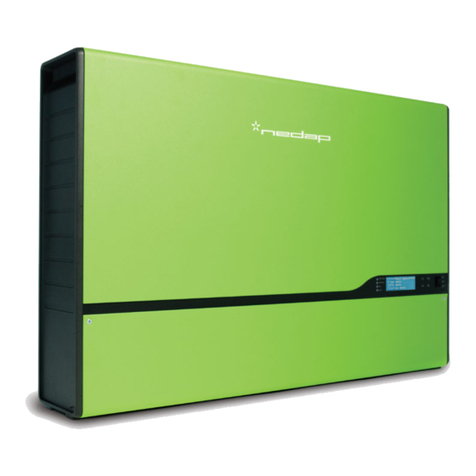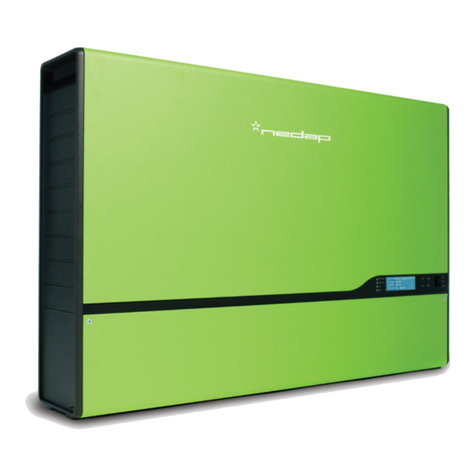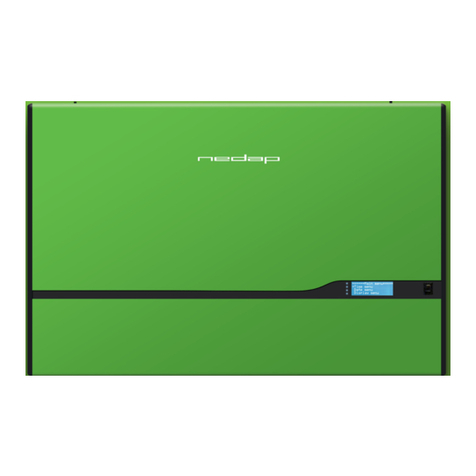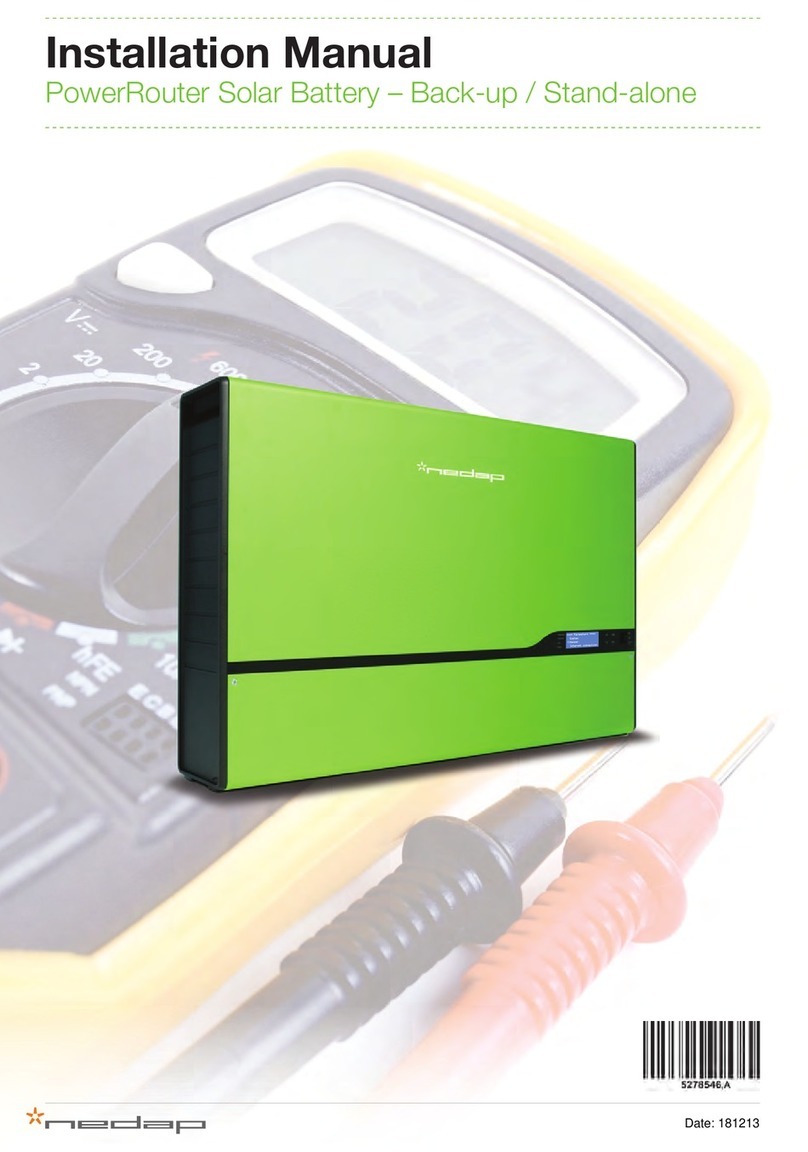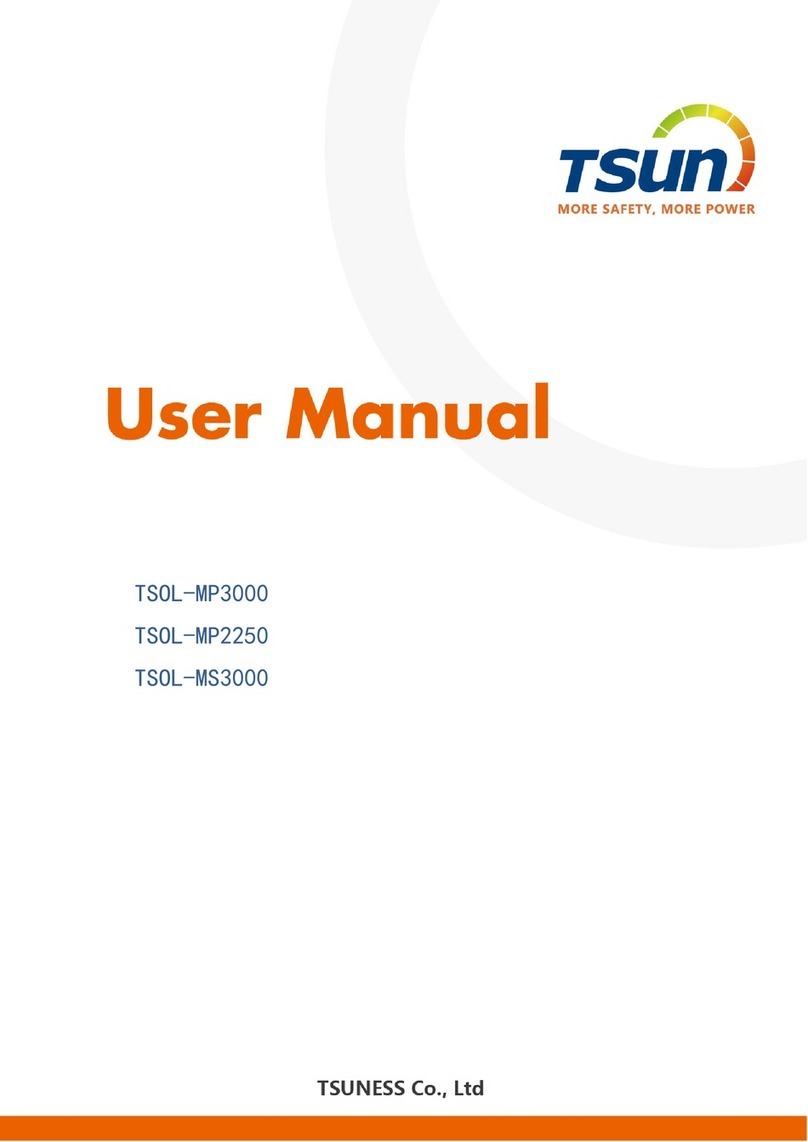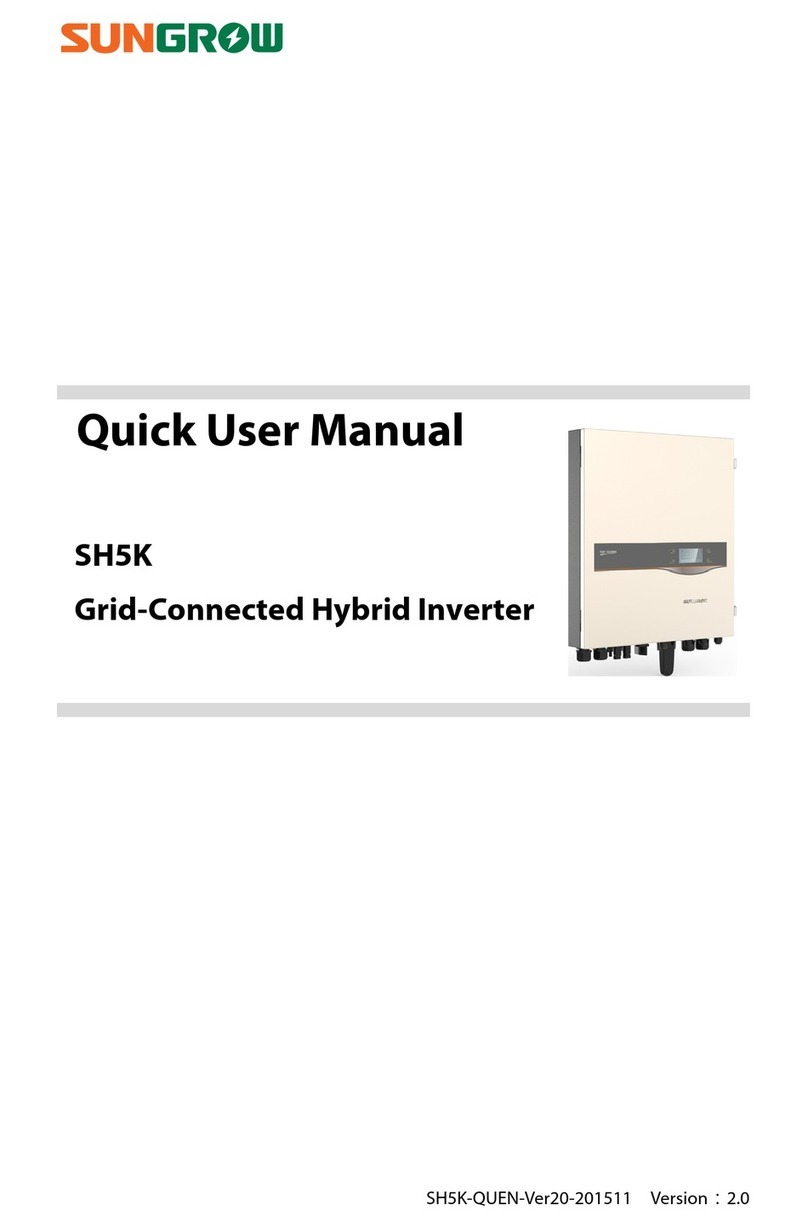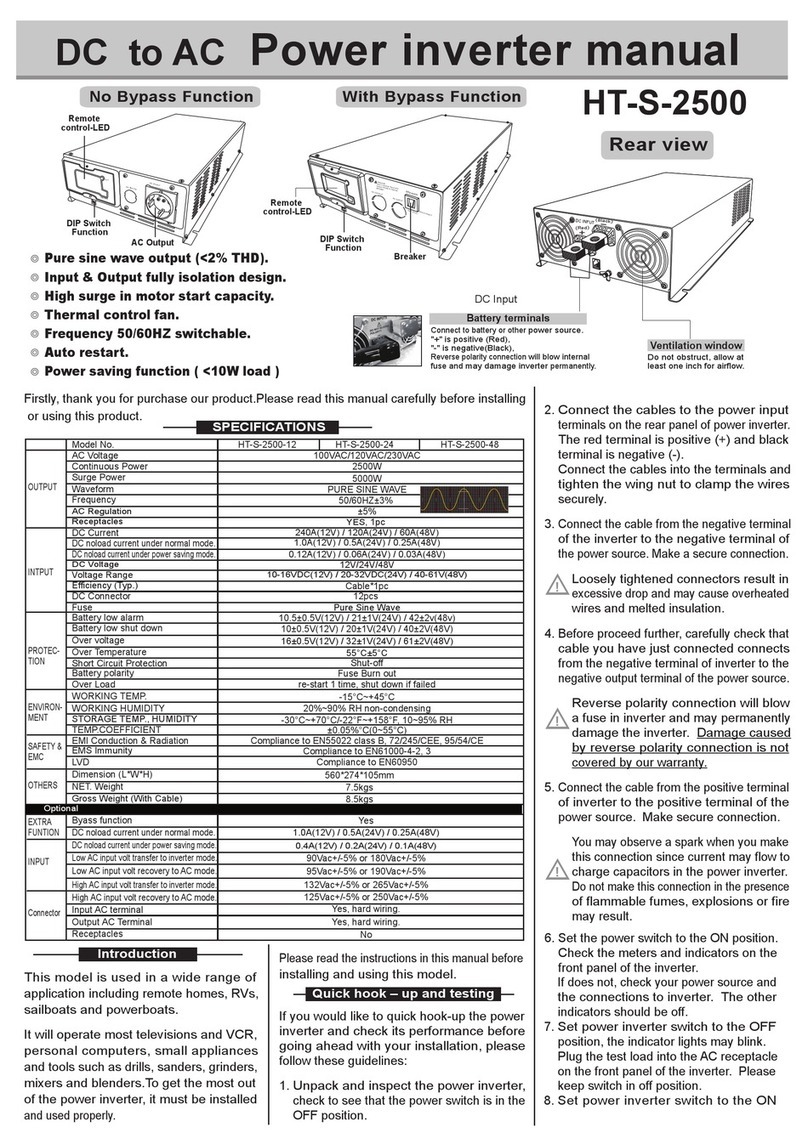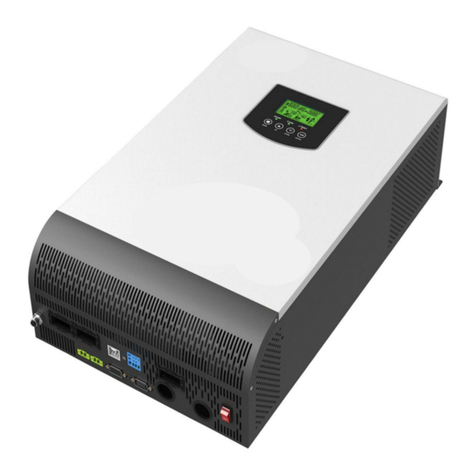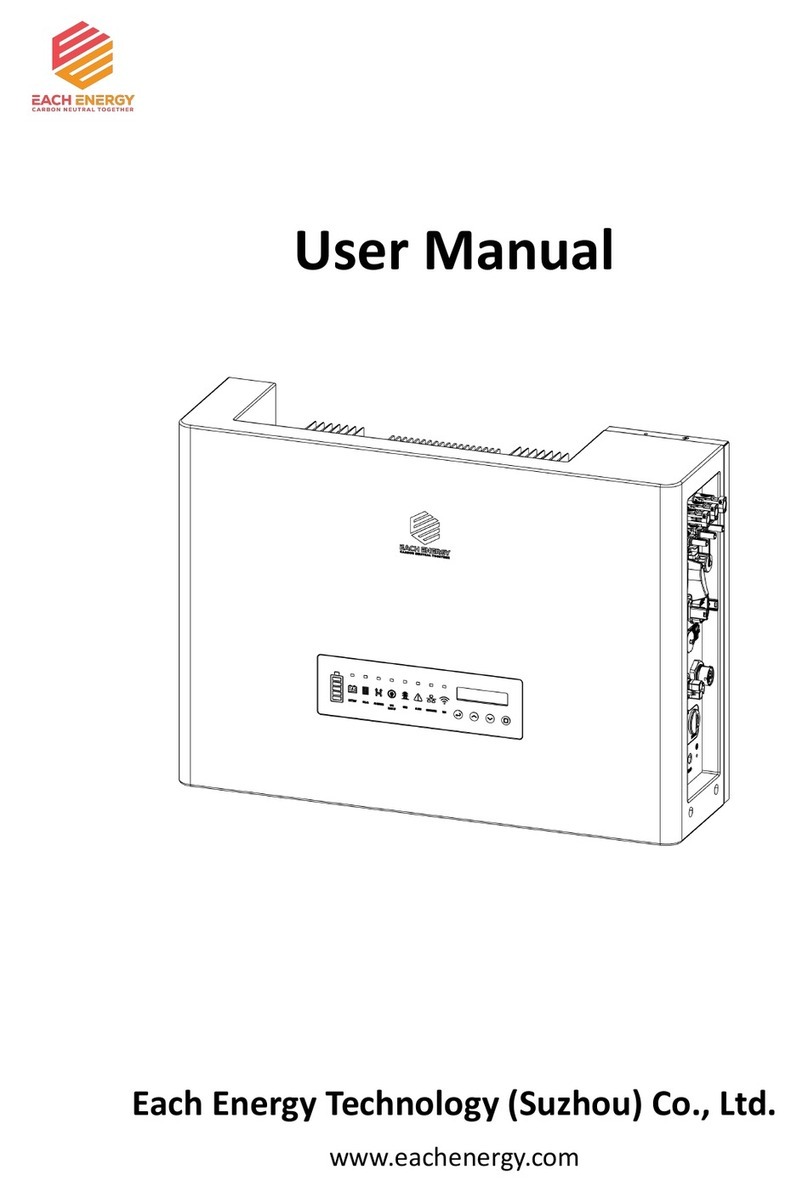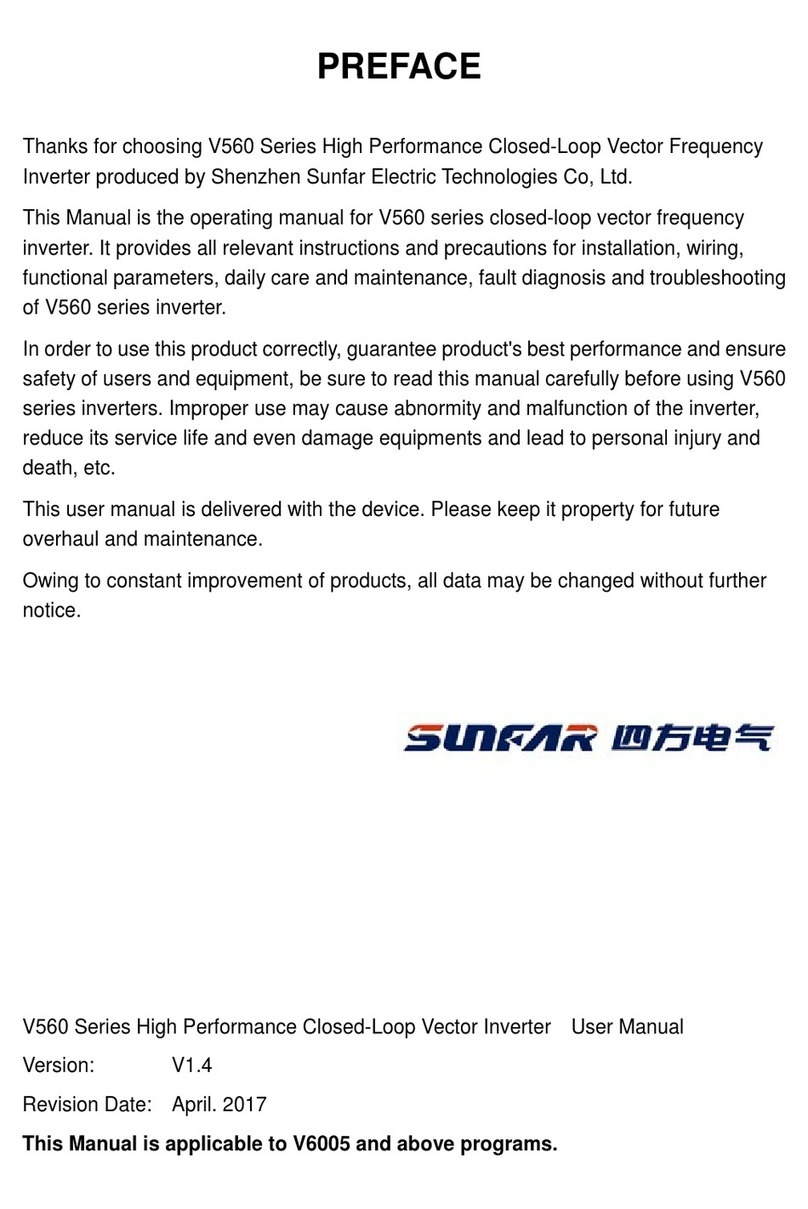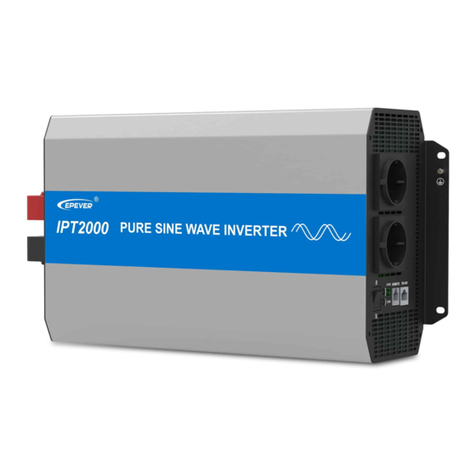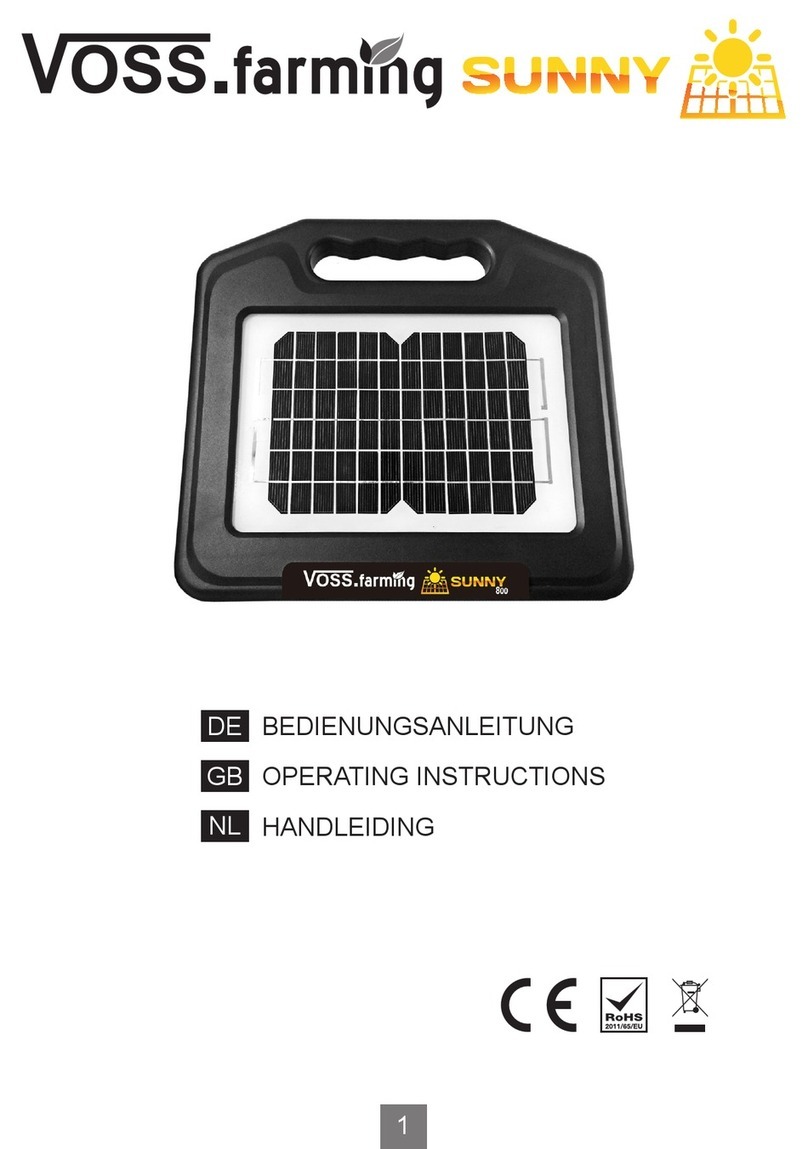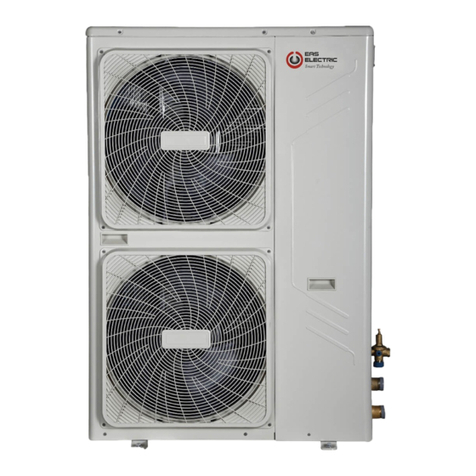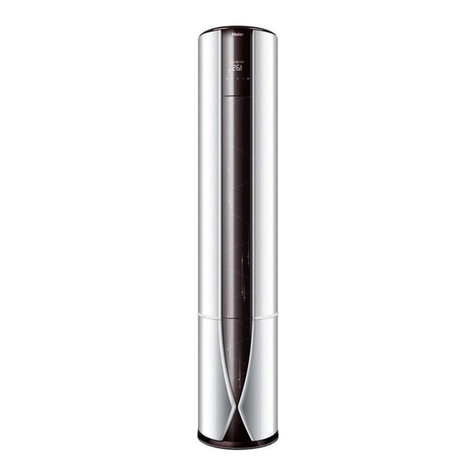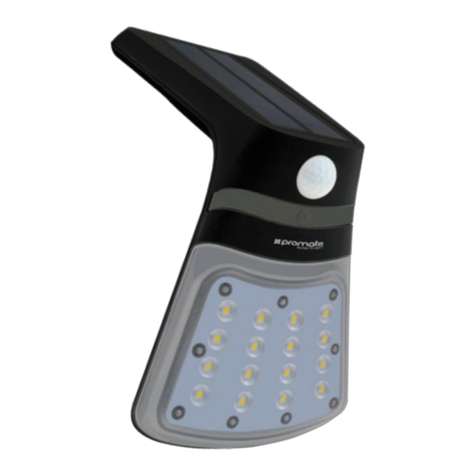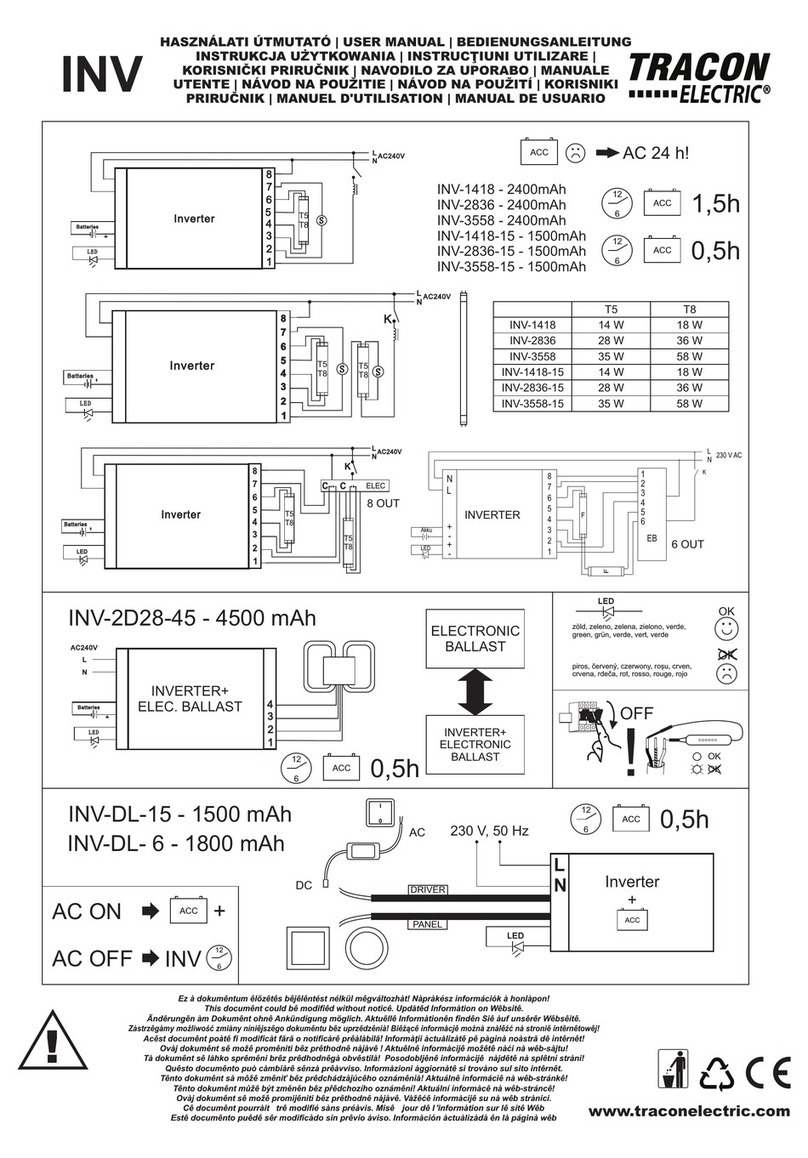Nedap PowerRouter PR30S User manual





EN
FR
IT
ES
PT
DE
NL
Installation manual
Page 6
Installationshandbuch
Seite 18
Manuel d’installation
Page 30
Installatie handleiding
Bladzijde 42
Manuale d'installazione
Pagina 54
Manual de instalación
Página 66
Manual de instalação
Página 78
N.V. Nederlandsche Apparatenfabriek “Nedap”
The Netherlands
PowerRouter Solar
3000W, 3700W and 5000W

EN
6
Safety Information
This manual contains instructions for the PowerRouter that should be followed during installation, operation and maintenance of the unit.
The PowerRouter is designed and tested according to international safety requirements. To reduce the risk of personal injury and to ensure
safe installation and operation of the PowerRouter, carefully read and follow all instructions, cautions and warnings in this installation manual.
The warning symbol indicates a hazard to either the equipment or personnel. It draws attention to a procedure which, if not correctly executed,
may result in damage to the PowerRouter or to the connected equipment. It could also result in personal injury.
Danger
This symbol indicates a hazardous situation which, if not avoided, will result in death or serious injury.
Warning
This symbol, when used alone or in conjunction with any of the following icons, indicates the need to consult the operating instructions
provided with the product. A potential risk exists if the operating instructions are not followed.
Caution
This symbol indicates a hazardous situation which, if not avoided, could result in minor or moderate injury.
Information
This symbol accompanies notes that call attention to supplementary information that you should know and use to ensure optimal operation of
the system.
A bullet with a number refers to an illustration with the same number. For illustrations refer to pages 2-4.
Contents
To help avoid problems during the installation, familiarize yourself with the installation process by reading the entire installation manual before
starting the installation.
Lethal voltages are present at various points in a solar system. For safety reasons, it is recommended that only qualified personnel install and
operate this equipment.
!
DANGER
!
WARNING
!
CAUTION
i
1
i
!
DANGER
Safety Information................................................................................................................................................................................................6
Contents................................................................................................................................................................................................................6
1 Introduction .......................................................................................................................................................................................................7
2 Safety..................................................................................................................................................................................................................7
3 Mounting ............................................................................................................................................................................................................7
3.1 Choosing a mounting location ......................................................................................................................................................................7
3.2 Dimensions and recommended clearances ................................................................................................................................................8
3.3 Mounting procedure.......................................................................................................................................................................................8
4 Wiring..................................................................................................................................................................................................................8
4.1 Wiring AC Connections..................................................................................................................................................................................8
4.2 Wiring Solar connections...............................................................................................................................................................................9
4.3 Bypass switch (for the professional models)...............................................................................................................................................9
4.4 Internet connection........................................................................................................................................................................................9
4.5 Optional CAN-bus ........................................................................................................................................................................................10
4.6 Free programmable general purpose contacts.........................................................................................................................................10
5 Commissioning................................................................................................................................................................................................10
6 Operation .........................................................................................................................................................................................................11
6.1 Navigating .....................................................................................................................................................................................................11
6.2 Service menu ................................................................................................................................................................................................11
7 Malfunctions and errors..................................................................................................................................................................................12
8 Cleaning and maintenance.............................................................................................................................................................................13
9 Decommissioning............................................................................................................................................................................................13
10 Disposal..........................................................................................................................................................................................................13
Appendix A Warranty........................................................................................................................................................................................14
Appendix B Error codes...................................................................................................................................................................................15
Appendix C Technical Specifications .............................................................................................................................................................16
Appendix D PV-MS tool....................................................................................................................................................................................17
Notes ...................................................................................................................................................................................................................17

EN
7
1 Introduction
This manual is suitable for the PowerRouter Solar types: PR30S (3000W), PR37S (3700W) and PR50S (5000W).
The manual is intended for certified installers to mount, wire and commission the PowerRouter unit.
The PowerRouter is a DC to AC grid-tied utility unit for use with Photovoltaics (PV). The PowerRouter can be used for feed-in purposes.
The optional AC local output of the PowerRouter supplies a no-break supply to the connected load in the event of a grid failure. For more
information visit: www.PowerRouter.com.
2 Safety
Before installing or using the PowerRouter, read all of the instructions, cautions, and warnings on the PowerRouter, the solar array and in this
installation manual. Before connecting the PowerRouter to the electric grid, contact the local utility company.
Solar arrays produce electrical energy when exposed to light and can thus create an electric shock hazard. Wiring of the solar arrays should
only be performed by qualified personnel.
The PowerRouter contains no user-serviceable parts. For all repairs and maintenance, contact your installer/dealer.
Anti-Islanding protection
The PowerRouter has a built-in anti-islanding protection functionality in compliance with local regulations.
During a utility failure, the PowerRouter unit will disconnect from the grid. With the optional "Local Out" you may continue supplying your
loads in this event.
Solar Series fusing
Serial fusing may be required depending on the type of PV module and configuration used in the system.
CE Compliance
The PowerRouter is compliant according to CE Directive.
3 Mounting
This chapter provides guidelines to help select the best mounting location, provides suggestions to ensure optimum performance, cautions
and warnings that you should follow in order to avoid injury and equipment damage. Also included are step-by-step instructions for
mounting the PowerRouter.
3.1 Choosing a mounting location
Take into account the following guidelines, cautions, and warnings when choosing a mounting location for the PowerRouter:
• The PowerRouter is designed for indoor installations (IP21)
• Do not install the PowerRouter in direct sunlight
• Do not install the PowerRouter on flammable construction materials
• Do not install the PowerRouter in areas where highly flammable materials are stored
• Do not install the PowerRouter in potentially explosive areas!
• Do not install the PowerRouter during periods of precipitation or high humidity (>95%); moisture trapped within the location may cause
corrosion and damage to the electronic components
• Install the PowerRouter in a location that maintains an ambient air temperature that is less than 40 °C; this is to maintain a safe internal
component temperature, the PowerRouter reduces power if the ambient air temperature exceeds 40 °C
• The PowerRouter should be installed in a location that is not accessible for children
• The PowerRouter emits a slight vibrating noise when operating. This noise is normal and has no effect on performance, but it can
be disturbing if the unit is mounted on a wall in a living area, on the outside of a wall that is near a living area, or on certain types of
materials, such as thin wood panelling or sheet metal
• The slope of the wall should be within ± 5°
• The PowerRouter weighs 15.5 kg; ensure that the mounting surface is strong enough to hold the weight of the PowerRouter
• The bottom of the PowerRouter is provided with a label showing the ratings; the PowerRouter must be mounted in such a manner that
this label remains visible after installation, as the label contains a serial number needed as a login code for the install wizard and to
register at www.myPowerRouter.com for logging and monitoring
If you are installing the PowerRouter in a cabinet, closet or other relatively small enclosed area, sufficient air circulation must be provided
in order to dissipate the heat generated by the unit. To prevent electric shock or other injury, check for existing electrical or plumbing
installations in the walls before drilling mounting holes for the PowerRouter.
!
WARNING
1
i

EN
8
3.2 Dimensions and recommended clearances
Mount the PowerRouter with 300 mm clearance at the top and bottom of the unit. If more PowerRouters are stacked, then use a clearance
of 800 mm between each PowerRouter. Use the drill template provided with the PowerRouter for drilling the bracket and mounting holes.
Ensure that there is sufficient clearance for the airflow around the PowerRouter! Local regulations may require larger working clearances.
Dimensions of the PowerRouter are 545 x 502 x 149 mm (W x H x D).
3.3 Mounting procedure
The PowerRouter is shipped with a wall-mounting bracket that is suitable for use on most walls.
Mounting procedure:
1. Use the drill template provided with the PowerRouter (follow the illustrated instructions on the drill template)
2. Drill holes for the mounting bracket in the wall (if required)
3. Drill holes for securing in the wall (if required)
4. Mount the mounting bracket
5. Install the PowerRouter on the mounting bracket
6. Open front cover and secure with screws (use screwdriver with a blade-length of 160 mm)
4 Wiring
This chapter provides step-by-step instructions and other information required for wiring the PowerRouter to the PV array, the utility grid and
the optional local out. To complete the installation in a safe and efficient manner, follow the steps in the right order.
Before wiring the PowerRouter, make sure that all wires connected to the PowerRouter are not live by turning off all disconnects and/or
switches.
Wiring steps:
1. Use the quick installation sheet provided with the PowerRouter
2. Connect the wires of the AC voltage from the utility grid and the load to the PowerRouter (refer to clause 4.1)
3. Connect the wires of the DC voltage from the PV array to the PowerRouter (refer to clause 4.2)
4.1 Wiring AC Connections
This clause describes the AC connections of the PowerRouter to the AC grid and the optional AC local out.
Use 4 mm² wires.
Wiring AC connection steps: (step 5,6 and 7 are optional)
1. Strip the insulation off the wires and pass the wires through the gland opening
2. Connect the AC Grid ground wire to the AC Grid ground terminal
3. Connect the AC Grid Line (L) wire to the AC Grid terminal labeled L
4. Connect the AC Grid Neutral (N) wire to the AC Grid terminal labeled N
5. Connect the AC Load ground wire to the AC Local Out ground terminal
6. Connect the AC Load Line (L) wire to the AC Local Out terminal labeled L
7. Connect the AC Load Neutral (N) wire to the AC Local Out terminal labeled N
8. Tighten strain reliefs
Example of an electrical residential installation.
Verify that all connections are correctly wired and properly torqued (min. 1.2 Nm, max. 1.5 Nm).
Contacts need to be free of any mechanical strain.
2
i
2
3
4
i

EN
9
4.2 Wiring Solar connections
This clause describes the connection between the solar panels and the PowerRouter.
Before connecting the PV string connectors to the PV terminals check this list:
• Set DC switch on the PowerRouter to OFF
• Use copper wire (4 mm2) for all PV wiring connections to the PowerRouter; apply only solid or stranded wire. Do not use fine stranded
wire
• Verify that the DC solar current and voltage of your installation does not exceed the maximum rates specified on the type rating label
• Check the polarity of the PV strings
• Use special tool for connecting MC4 connector on the PV wires; the PV MS tool is described in Appendix D
Connect 1 or 2 strings to the PV input terminals using mating MC4 connectors.
The 3kW unit only has 1 PV input.
Do not connect 1 PV-string to both PV-terminals simultaneously (parallel connection).
Do not connect 1 PV-string to both PV-terminals in serial.
4.3 Bypass switch (for the professional models)
This clause describes the usage of a bypass switch.
The PowerRouter professional models use the 'Local Out' to supply your loads. This unique feature enables it to supply backup power in the
event of a grid failure, as a PowerRouter with a 'Local Out' connection can switch to 'island mode' when the grid fails. After a short delay it
resumes operation, enabling its unique 'Local Out' connection to supply a stable 230Vac power signal to the connected loads.
Bypass switches are crucial components with which the PowerRouter supports critical load situations. (The PowerRouter acts as a UPS
system). The bypass switch allows you to switch off the PowerRouter for maintenance, without cutting power to the load. When the switch
is activated, the mains supply is directed away from the PowerRouter and is directly connected to the load. The PowerRouter can then be
serviced and any maintenance work carried out without disturbing the load. Once the PowerRouter is ready to be switched on, the bypass
switch is deactivated and the supply is redirected to the PowerRouter; the load receives the PowerRouter supply again.
The Bypass switch is an optional component and should be obtained and installed separately. (Bypass switch contacts ratings = 230V 40A).
The AC grid input and AC local output circuits are isolated from the enclosure and system grounding.
AC grounding: connect the PowerRouter to the AC ground from the utility via the ground terminal (PE).
PV Grounding: check local regulations. DC Grounding Electrode Conductor: a DC grounding electrode conductor may be required by the
local authorities. The AC local out connection of the PowerRouter is an optional connection, depending on how the PowerRouter will be
used.
4.4 Internet connection
This clause describes the connection of the PowerRouter to the internet.
When the PowerRouter is connected to the internet, the web portal myPowerRouter.com gives detailed system information (e.g.
performance, profit, solar yield) on each PowerRouter unit. The PowerRouter can even be remotely updated with new firmware containing
the latest features, so your system is always up to date.
Connecting the PowerRouter to the internet with standard UTP / RJ45 network cable to your internet router / gateway / switch.
More information about possible connections to the internet is available on www.PowerRouter.com.
The PowerRouter only uses Internet port 80, this is normally a standard setting of the network. It can be tested by connecting a PC to this
connection and trying to surf on the internet. In case of applying a proxy, contact your installer/dealer.
5
6
!
CAUTION
7
i
8
11
i

EN
10
4.5 Optional CAN-bus
This clause describes the optional CAN-bus of the PowerRouter.
This connector is for future use and is covered with a plug to prevent misconnection with the internet port.
Check www.PowerRouter.com to find out for when this option becomes available.
4.6 Free programmable general purpose contacts
This clause describes the PowerRouter general purpose contacts functionality.
Two programmable contacts are available and the contacts are potential-free with the ratings: 230Vac - 1 A / 24Vdc - 1 A.
The contacts switch over when grid levels are exceeded, and they switch back in safe conditions. The triplevels are adjustable with the
install wizard and installation software tool; see also clause 6.2. The left contacts can be used for grid alarms, the right contacts is for future
use.
5 Commissioning
This chapter describes the commissioning of the PowerRouter.
Before using the PowerRouter, the unit must be initialized by setting system parameters. There are 2 methods to set the system parameters:
A. Using the built-in install wizard
B. Using the software installation tool with a PC connected to the PowerRouter's USB port
Commissioning method A (recommended):
1. Switch utility grid to the PowerRouter
2. Switch the main switch of the PowerRouter to ON, the install wizard will start, set system parameters of the PowerRouter by using the
install wizard
3. Switch PV-panels (with DC switch) and load to the PowerRouter
Commissioning method B (for advanced settings):
1. Insert a USB cable into the USB port of the PowerRouter and to a PC.
2. Switch utility grid to the PowerRouter
3. Switch the main switch of the PowerRouter to ON, use the software installation tool and set the system parameters
4. Switch PV-panels (with DC switch) and load to the PowerRouter
After commissioning, the PowerRouter is ready to use.
The USB port:
The PowerRouter can be initialized by using the PowerRouter software installation tool.
Download the PowerRouter software installation tool and driver via the PowerRouter website: www.PowerRouter.com/software (you need
your login details for this website). Check the Business Partner website regularly for updates to the PowerRouter software installation tool.
Connect the PowerRouter to a PC with a standard USB B-type to A-type cable, and you can then use the software installation tool.
8
9
i

EN
11
6 Operation
This chapter describes the operation of the PowerRouter.
The PowerRouter has 4 buttons to operate. Navigating and changing values can be done by using these 4 buttons.
The 4 rows display shows the menus and other information like status, history and error messages. The user manual provided with the
PowerRouter explains how to operate the PowerRouter and is intended for the end-user. This chapter explains the service menu.
6.1 Navigating
Navigation buttons:
• Up / Down Scroll through the menus or list or change value
• Yes Confirm choice or select item
• No Return to previous state
6.2 Service menu
This clause provides information about the service menu.
The service menu gives access to service-related functions like Reset, Self test, Error history, internet connection and Install wizard.
Overview of the menu structure.
6.2.1 Reset
If the PowerRouter is not working as expected then a reset can help. The PowerRouter will then be restarted, and during this restart the load
will be disconnected. This means that during this event no power will be available for the end-user, depending on the configuration.
The restart duration is less than 1 minute.
Reset procedure:
1. Enter the service menu
2. Select Reset
3. Press YES to continue
4. Press YES to start the Reset procedure
The PowerRouter should work as normal, otherwise contact your installer/dealer.
6.2.2 Self test
The self test is a safety check required by some countries. During this test the PowerRouter will simulate the grid voltage and frequency, the
PowerRouter should respond safely on the simulated grid abnormalities. The test will pass if the PowerRouter responds within the country
given specifications; otherwise the PowerRouter shuts down.
Self test procedure:
1. Enter the service menu
2. Select Self test
3. Press YES to start the Self test procedure
When the PowerRouter shuts down, start the PowerRouter and run the self test again. If it still fails contact your installer/dealer.
6.2.3 Error history
The error history holds the last 10 error messages which have occurred.
When contacting your installer/dealer, the error codes in the error history can be helpful to determine the problem.
Error history readout procedure:
1. Enter the service menu
2. Select Error history
3. Press YES to enter the Error history
4. Press Up/Down to scroll through the error list
12
13
i
i


EN
13
How to deal with errors
An error may prevent the system from operating. Before the system can operate again, the error has to be cleared. Errors are cleared
automatically by the system if the error condition disappears. When the error message stays, press a button (YES or NO or UP/DOWN) on
the PowerRouter to clear the error. Also the error message can be cleared using the installation software tool or via the internet.
Clear error message procedure:
1. Press NO for at least 3 seconds
Troubleshooting
If you encounter difficulty with the operation of your PowerRouter, please follow these steps in an effort to correct the problem:
• Check the LED display
• Check and record the error message on the LCD display or other communication system available and take appropriate action to
correct the issue by referring to the error codes in Appendix D
• If the system problem persists, contact your installer/dealer
When contacting your installer, provide the following information:
• Serial number
• Model number
• Short description of the problem
• Display message
• Error codes listed in the Service/Error history menu
Error codes are listed in Appendix B and will also be available on myPowerRouter.com.
8 Cleaning and maintenance
This chapter describes the cleaning and maintenance of the PowerRouter.
Clean every 12 months (once per year) the housing with a dry cloth and check that there is no airflow obstruction. Remove any dust build-up
from the locations as indicated. Check the PowerRouter and the cables for visible external damage on a regular basis.
When cleaning the airflow holes inside the housing, cut off the power from the PowerRouter unit by decommissioning or by using a bypass
switch.
Internal cleaning is only to be carried out by certified persons. Contact your installer/dealer if you find any defects. Do not perform any repair
work yourself.
9 Decommissioning
This chapter describes the decommissioning procedure of the PowerRouter.
The decommissioning procedure is needed to safely remove the PowerRouter.
Decommissioning procedure:
1. Switch the PowerRouter unit OFF
2. Switch OFF DC-switches or disconnects (Solar)
3. Switch OFF AC-switches or disconnects (Grid / Load)
4. Wait 5 minutes for de-energizing
5. Disconnect communication and optional connections wirings
6. Disconnect PV wiring with the special tool as described in Appendix D (Solar)
7. Disconnect AC wiring (Grid / Load)
The PowerRouter can now be removed for disposal or repair.
Decommissioning should only be carried out by certified persons. Contact your installer/dealer.
10 Disposal
This chapter describes procedures for disposal of the PowerRouter.
When the PowerRouter needs to be disposed of because it has reached the end of its life, or for other reasons, have this carried out
according to local waste handling regulations. The PowerRouter must not be disposed of with household waste. Instead, it is the end-user's
responsibility to have it disposed of by handing it over to a designated collection point for the recycling of waste electrical and electronic
equipment.
i
!
CAUTION
!
CAUTION

EN
14
Appendix A Warranty
PowerRouter factory warranty conditions
Our quality control program ensures that each PowerRouter product is manufactured to exact specifications and is thoroughly tested before
leaving the factory.
5 year warranty
The Nedap factory warranty period is 5 years as from the purchase date of the PowerRouter system. The warranty conditions are based on
the European EU directive no. 99/44/EG. The legal rights are applied for unimpeded.
Extended warranty
For all PowerRouter systems you can acquire an extension of 5 years on the PowerRouter factory warranty, up to a total of 10 years
warranty. The warranty is only available if purchased within 6 months of the PowerRouter delivery date.
Warranty conditions
If a PowerRouter becomes defective during the relevant PowerRouter warranty period, one of the following services, as selected by the
PowerRouter Helpdesk, will be performed at no charge for materials, exclusive of labor costs:
• Repair at Nedap N.V., or
• Repair on-site, or
• Exchange for a replacement unit (of equivalent value according to model and age)
Exclusion of liability
Warranty claims and liability for direct or indirect damage are excluded if arising from:
• Transport and storage damage
• Incorrect installation and/or commissioning
• Modifications, changes or attempted repairs by untrained and unauthorized personnel
• Incorrect use or inappropriate operation
• Insufficient ventilation of the unit
• Failure to observe the applicable safety regulations
• Force majeure (e.g. lightning, overvoltage, storm, fire)
• Cosmetic shortcomings which do not influence the functioning of the unit
• Damage due to moisture and/or other environmental conditions
The installer/dealer who installed the PowerRouter must report the defective PowerRouter system to the PowerRouter Helpdesk.
Nedap reserves the right to replace the unit with an equal or better specification according to Nedap's judgement.
Disclaimer
All rights to the content of this manual are owned by N.V. Nederlandsche Apparatenfabriek “Nedap” (hereinafter Nedap). By using this
manual you accept the terms of this disclaimer.
Nedap has made every effort to ensure that this manual is accurate. Nedap disclaims liability for any inaccuracies or omissions that may
have occurred and for any damages arising from or related to the use of this manual.
No published data in this manual may be reproduced or published in any form or by any means without prior written consent by Nedap.
Information in this manual is subject to change without notice and does not represent any commitment on the part of Nedap. Nedap makes
no commitment to update or keep current the information in this manual, and reserves the right to make improvements to this manual and/
or to the products described in this manual, at any time without notice. If you find information in this manual that is incorrect, misleading, or
incomplete, we would appreciate your comments and suggestions.
i



EN
17
Appendix D PV-MS tool
To prevent damage of the PV connectors when disconnecting the PV from the PowerRouter, it's advisable to use the PV-MS tool to open the
connector locking mechanism.
PV disconnection procedure:
1. Insert PV-MS tool with the pins to the connector
2. Pull the PV connector out of the PowerRouter
This tool is not delivered with the PowerRouter, Installers/dealers can order the tool from Multi-Contact at www.multi-contact.com.
Type: PV-MS, Order no.: 32.6024, Designation: Open-end-spanner set.
Notes
i

DE
18
Sicherheitshinweise
Dieses Handbuch enthält Anweisungen für die Installation, den Betrieb und die Wartung des PowerRouters.
Der PowerRouter wurde gemäß den internationalen Sicherheitsbestimmungen entwickelt und geprüft. Um das Verletzungsrisiko herabzusetzen
und eine sichere Installation sowie einen sicheren Betrieb des PowerRouters zu gewährleisten, lesen und befolgen Sie alle Anweisungen,
Sicherheits- und Warnhinweise in diesem Installationshandbuch sorgfältig.
Das Warnsymbol weist auf eine Gefahr für Personen und Ausrüstung hin. Es macht auf ein Verfahren aufmerksam, das bei nicht ordnungsgemäßer
Ausführung zu Schäden am PowerRouter oder der angeschlossenen Ausrüstung führen kann. Außerdem kann dies unter Umständen zu
Personenschäden führen.
Gefahr
Dieses Symbol weist auf eine gefährliche Situation hin. Eine Nichtbeachtung dieses Hinweises kann zu Tod oder zu schweren Verletzungen
führen.
Warnung
Dieses Symbol weist entweder eigenständig oder zusammen mit den folgenden Symbolen darauf hin, in den Gebrauchsanweisungen
nachzuschlagen, die mit diesem Produkt ausgeliefert wurden. Werden die Gebrauchsanweisungen nicht befolgt, besteht ein potenzielles
Risiko.
Vorsicht
Dieses Symbol weist auf eine gefährliche Situation hin. Eine Nichtbeachtung dieses Hinweises kann zu leichten oder mittelschweren
Verletzungen führen.
Information
Dieses Symbol ist bei Hinweisen mit zusätzlichen, wissenswerten Informationen zu finden, die für einen optimalen Betrieb der Anlage
anzuwenden sind.
Ein nummeriertes Aufzählungszeichen weist auf eine Abbildung mit derselben Nummer hin. Die Abbildungen befinden sich auf den Seiten 2
bis 4.
Inhalt
Um Probleme während der Installation zu vermeiden, lesen Sie vor Beginn der Installation das Installationshandbuch vollständig durch, um
sich mit dem Installationsverfahren vertraut machen.
An bestimmten Stellen von Solaranlagen treten tödliche elektrische Spannungen auf. Aus Sicherheitsgründen wird empfohlen, dass diese Art
von Ausrüstung nur von dafür qualifiziertem Personal installiert und bedient wird.
!
GEFAHR
!
WARNUNG
!
VORSICHT
i
1
i
!
GEFAHR
Sicherheitshinweise ...........................................................................................................................................................................................18
Inhalt....................................................................................................................................................................................................................18
1 Einleitung .........................................................................................................................................................................................................19
2 Sicherheit .........................................................................................................................................................................................................19
3 Montage ...........................................................................................................................................................................................................19
3.1 Auswahl eines Montageortes......................................................................................................................................................................19
3.2 Abmessungen und empfohlene Montageabstände ..................................................................................................................................20
3.3 Montageverfahren ........................................................................................................................................................................................20
4 Verdrahtung......................................................................................................................................................................................................20
4.1 Verdrahtung der AC-Anschlüsse.................................................................................................................................................................20
4.2 Verdrahtung der Solaranschlüsse...............................................................................................................................................................21
4.3 Bypass-Schalter (bei Professional-Modellen) ...........................................................................................................................................21
4.4 Internet-Anschluss (Internet connection) ..................................................................................................................................................21
4.5 Optionaler CAN-Bus ....................................................................................................................................................................................22
4.6 Frei programmierbare Mehrzweckkontakte ..............................................................................................................................................22
5 Inbetriebnahme................................................................................................................................................................................................22
6 Bedienung ........................................................................................................................................................................................................23
6.1 Navigation .....................................................................................................................................................................................................23
6.2 Menü Wartung (Service)...............................................................................................................................................................................23
7 Störungen und Fehler .....................................................................................................................................................................................24
8 Reinigung und Wartung ..................................................................................................................................................................................25
9 Außerbetriebnahme.........................................................................................................................................................................................25
10 Entsorgung.....................................................................................................................................................................................................25
Anhang A Garantie ...........................................................................................................................................................................................26
Anhang B Fehlercodes.....................................................................................................................................................................................27
Anhang C Technische Daten ...........................................................................................................................................................................28
Anhang D PV-MS-Werkzeug............................................................................................................................................................................29
Notizen ................................................................................................................................................................................................................29

DE
19
1 Einleitung
Dieses Handbuch behandelt die PowerRouter Solar vom Typ: PR30S (3000W), PR37S (3700W) und PR50S (5000W).
Dieses Handbuch richtet sich an zertifizierte Installateure, die die PowerRouter-Einheit montieren, verdrahten und in Betrieb nehmen.
Bei dem PowerRouter handelt es sich um eine netzgekoppelte DC-AC-Versorgungseinheit zur Verwendung mit Photovoltaikanlagen (PV).
Der PowerRouter kann auch zur Einspeisung verwendet werden. Der optionale lokale AC-Ausgang des PowerRouters sorgt bei einem
Netzausfall für eine unterbrechungsfreie Stromversorgung des angeschlossenen Lastkreises. Weitere Informationen erhalten Sie unter: www.
PowerRouter.com.
2 Sicherheit
Lesen Sie vor der Installation oder dem Betrieb des PowerRouters alle Anweisungen, Sicherheits- und Warnhinweise auf dem PowerRouter
und der Photovoltaikanlage sowie in diesem Installationshandbuch sorgfältig durch. Informieren Sie Ihren örtlichen Energieversorger, bevor
Sie den PowerRouter an das öffentliche Stromnetz anschließen.
Sobald Solarmodule Licht ausgesetzt sind, erzeugen sie elektrische Energie und können damit auch elektrischen Schlag verursachen.
Sämtliche Verdrahtungsarbeiten an Solarmodulen dürfen nur von qualifizierten Fachkräften ausgeführt werden.
Der PowerRouter enthält keine Komponenten, die vom Benutzer gewartet werden dürfen. Wenden Sie sich für alle Reparatur- und
Wartungsarbeiten an den Installateur bzw. Händler.
Netzüberwachung
Der PowerRouter verfügt in Übereinstimmung mit den lokalen Bestimmungen über eine Netzüberwachungsfunktion.
Bei einem Ausfall des Stromnetzes wird der PowerRouter vom Netz getrennt. Mit dem optionalen „Local Out“-Ausgang können Sie Ihren
Lastkreis in einem solchen Fall weiter versorgen.
In Reihe geschaltete Überstromschutzeinrichtungen
Je nach dem Typ der im Gerät eingesetzten und konfigurierten PV-Module können in Reihe geschaltete Überstromschutzeinrichtungen
erforderlich sein.
Erfüllung der CE-Richtlinie
Der PowerRouter entspricht der CE-Richtlinie.
3 Montage
Dieses Kapitel enthält Hinweise zur Wahl des besten Montageortes, Vorschläge zur Gewährleistung der optimalen Leistung sowie
Sicherheits- und Warnhinweise, die zur Vermeidung von Sach- und Personenschäden einzuhalten sind. Außerdem wird in einer schrittweisen
Anleitung die Montage des PowerRouters beschrieben.
3.1 Auswahl eines Montageortes
Berücksichtigen Sie bei der Wahl eines geeigneten Montageortes für den PowerRouter die folgenden Richtlinien sowie Sicherheits- und
Warnhinweise:
• Der PowerRouter ist für den Einsatz im Innenbereich konstruiert (IP21).
• Der PowerRouter darf am Montageort nicht direktem Sonnenlicht ausgesetzt sein.
• Niemals den PowerRouter auf entflammbaren Baustoffen installieren.
• Niemals den PowerRouter in Bereichen installieren, in denen hoch entzündliche Materialien gelagert werden.
• Niemals den PowerRouter in potenziell explosionsgefährdeten Bereichen installieren!
• Niemals den PowerRouter in der Zeit von Niederschlägen oder hoher Luftfeuchtigkeit (>95 %) installieren; die möglicherweise
eingeschlossene Feuchtigkeit kann zur Korrosion und Beschädigung der elektronischen Bauteile führen.
• Installieren Sie den PowerRouter an einem Montageort mit einer Umgebungslufttemperatur von weniger als 40 °C; um für die internen
Gerätekomponenten eine sichere Temperatur zu gewährleisten, drosselt der PowerRouter bei Umgebungslufttemperaturen über 40 °C
möglicherweise seine Leistung.
• Der PowerRouter muss an einem Montageort installiert sein, der Kindern nicht zugänglich ist.
• Während des Betriebs gibt der PowerRouter ein leises Vibrationsgeräusch ab. Dieses Geräusch ist normal und hat keinerlei Einfluss auf
die Geräteleistung. Es kann allerdings bei einer Montage an Wänden in Wohnräumen oder selbst schon in der Nähe von Wohnräumen
bzw. bei Montage auf bestimmten Materialien, wie z. B. dünnen Holzpaneelwänden oder Metallblechen, störend sein.
• Der Neigungswinkel der Wand sollte ± 5 nicht übersteigen.°
• Das Gewicht des PowerRouters beträgt 15,5 kg; vergewissern Sie sich, dass die Montagefläche für das Gewicht des PowerRouters
stark genug ausgelegt ist.
• An der Unterseite des PowerRouters befindet sich ein Schild mit den technischen Angaben; der PowerRouter muss so montiert
werden, dass dieses Schild nach der Installation weiterhin sichtbar ist. Das Schild enthält eine Seriennummer, die als Anmeldecode für
die Installationshilfe (Install wizard) und bei der Registrierung unter www.myPowerRouter.com zu Anmelde- und Überwachungszwecken
benötigt wird.
Wenn Sie den PowerRouter in einem Schaltschrank, Gehäuse oder einem anderen relativ kleinen geschlossenen Bereich installieren, müssen
Sie eine ausreichende Abfuhr der vom Gerät erzeugten Wärme sicherstellen. Überprüfen Sie vor dem Bohren von Befestigungslöchern für
den PowerRouter die Wand auf möglicherweise darin verlaufende Versorgungsleitungen aller Art, um der Gefahr eines elektrischen Schlages
oder Verletzungen anderer Art vorzubeugen.
!
WARNUNG
1
i

DE
20
3.2 Abmessungen und empfohlene Montageabstände
Montieren Sie den PowerRouter so, dass an der Ober- und Unterseite des Geräts 300 mm Freiraum eingehalten werden. Wenn mehrere
PowerRouter zusammengefasst werden, halten Sie einen Abstand von jeweils 800 mm zwischen den PowerRoutern ein. Verwenden Sie zum
Bohren der Halterungs- und Montagelöcher die mit dem PowerRouter ausgelieferte Bohrschablone.
Stellen Sie einen ausreichenden Abstand für einen ungehinderten Luftstrom um den PowerRouter sicher! Örtliche Richtlinien können
allerdings größere Abstände vorschreiben.
Die Abmessungen des PowerRouters betragen 545 x 502 x 149 mm (B x H x T).
3.3 Montageverfahren
Der PowerRouter wird mit einem Wandbefestigungshalter ausgeliefert, mit dem Sie das Gerät auf den meisten Wandtypen befestigen
können.
Vorgehen bei der Montage:
1. Verwenden Sie die mit dem PowerRouter ausgelieferte Bohrschablone (folgen Sie den bebilderten Anweisungen auf der Schablone).
2. Bohren Sie Löcher für den Wandbefestigungshalter in die Wand (sofern benötigt).
3. Bohren Sie Löcher für die Absicherung in die Wand (sofern benötigt).
4. Bringen Sie die Befestigungshalterung an.
5. Montieren Sie den PowerRouter an der Befestigungshalterung.
6. Öffnen Sie die vordere Abdeckung und drehen Sie die Sicherungsschrauben ein (verwenden Sie einen Schraubendreher mit einer
Klingenlänge von 160 mm).
4 Verdrahtung
In diesem Kapitel werden die einzelnen Verdrahtungsschritte und weitere wichtige Informationen für den Anschluss des PowerRouters an
Photovoltaikanlage, öffentliches Versorgungsnetz und für den optionalen lokalen Ausgang beschrieben. Führen Sie alle Schritte in der hier
aufgeführten Reihenfolge durch, um die Installation auf eine sichere und effiziente Weise durchzuführen.
Stellen Sie vor der Verdrahtung des PowerRouters sicher, dass alle an den PowerRouter anzuschließenden Drähte spannungslos sind, indem
Sie alle Trennvorrichtungen bzw. Schalter ausschalten.
Verdrahtungsschritte:
1. Ziehen Sie die Installations-Kurzanleitung heran, die mit dem PowerRouter ausgeliefert wurde.
2. Schließen Sie die Drähte für die AC-Spannung von Netz und Lastkreis an den PowerRouter an (siehe Abschnitt 4.1).
3. Schließen Sie die Drähte für die DC-Spannung von der PV-Anlage an den PowerRouter an (siehe Abschnitt 4.2).
4.1 Verdrahtung der AC-Anschlüsse
In diesem Abschnitt werden die AC-Anschlüsse des PowerRouters zum AC-Netz und dem optionalen lokalen AC-Ausgang beschrieben.
Verwenden Sie Drähte mit 4 mm² Querschnitt..
Verdrahtungsschritte für die AC -Anschlüsse: (die Schritte 5, 6 und 7 sind optional)
1. Isolieren Sie die Drähte ab und legen Sie sie durch die Öffnung der Kabeldurchführung.
2. Schließen Sie den vom AC-Netz kommenden Erdleiter an die AC-Grid-Erdungsklemme an.
3. Schließen Sie den vom AC-Netz kommenden Außenleiter (L) an die AC-Grid-Klemme L an.
4. Schließen Sie den vom AC-Netz kommenden Neutralleiter (N) an die AC-Grid-Klemme N an.
5. Schließen Sie den vom AC-Lastkreis kommenden Erdleiter an die AC-Local-Out-Erdungsklemme an.
6. Schließen Sie den vom AC-Lastkreis kommenden Außenleiter (L) an die AC-Local-Out-Klemme L an.
7. Schließen Sie den vom AC-Lastkreis kommenden Neutralleiter (N) an die AC-Local-Out-Klemme N an.
8. Ziehen Sie dann die Zugentlastung an.
Beispiel für eine Elektroinstallation in Wohnhäusern.
Überprüfen Sie, ob alle Anschlüsse ordnungsgemäß verdrahtet und mit dem richtigen Anzugsmoment (min. 1,2 Nm, max. 1,5 Nm)
angezogen sind.
Die Kontakte dürfen keiner mechanischen Zugbelastung ausgesetzt sein.
2
i
2
3
4
i
Other manuals for PowerRouter PR30S
1
This manual suits for next models
2
Table of contents
Languages:
Other Nedap Inverter manuals
